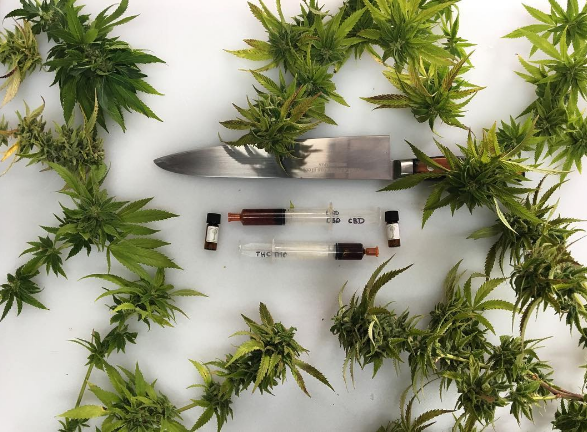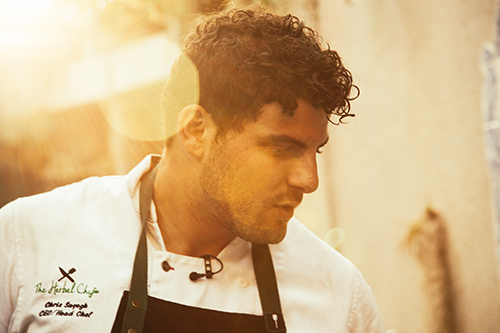Legalization of recreational marijuana in American states is on the upswing, spurring entrepreneurs to devise new ways to use the flowering psychoactive herb such as CBD and THC as an ingredient in retail food products. California-based chef Christopher Sayegh is taking Arab haute cuisine even higher, cooking up traditional Middle Eastern fare infused with cannabis.
Marijuana edibles created by companies such as Wyld offer a popular alternative to the traditional way we enjoy weed (smoking marijuana by joint, pipe, or bong).
They also offer a convenient – and discreet – way to consume cannabis, particularly for those who dislike smoke. Many users report that edibles offer a more relaxing high than smoking pot – described as a “full body” high instead of a “head” high.
On the downside, the effects of edibles can be unpredictable, varying wildly among users.

To date, 24 US states have legalized medical marijuana and recreational pot use is fully legal for adults in Alaska, Colorado, Oregon, Washington and the District of Columbia. Cannabis is now legal in Canada. As the stigma surrounding marijuana gradually lessens, the entrepreneurial rush to capitalize on its appeal increases.
According to cannabis investment and research firm Arcview Group, legal pot sales in the US totalled $1.2 billion in 2015, a 232 percent increase over 2014. They predict sales to exceed $22 billion by 2020.

Let’s get back in the kitchen with Chef Sayegh. Midway to a degree in molecular biology, he dropped out of university to explore cooking, then honed his culinary skills working in Michelin-starred restaurants in New York and California.
Sayegh got in at the start of the edible drug craze. In 2014 he started The Herbal Chef, his Los Angeles-based business that focuses on cannabis-spiked foods. “I am trying to give people a cerebral experience,” 24-year-old Sayegh told Indoology. “But I’m also really careful in how I take them along on this journey.”
“I am literally changing people’s brain chemistry as the dishes go on,” he said, “By the third course you feel it a little, by the fourth a bit more and by the fifth course, you’re starting to hit your groove. So it’s like a symphony,” he added. “I have to make sure that as the come-up is happening, the dishes correspond with that and as it’s coming down, the same happens.”
Pot food products are made by infusing “normal” recipes with cannabis. The first wave of edibles came in the shape of simple snacks, think pot-laced baked goods, candy and popcorn. Sayegh took it up several notches, introducing cannabis to haute cuisine. He works exclusively on private affairs for people who hold medical marijuana cards. His meals, which cost up to $500 each, aim to bring diners on a unique “immersive” journey. It’s not just about getting stoned.
The Jordanian-born cook fills syringes with a cannabis compound, and injects sauces, breads, and juicy cuts of meat. He experiments with classic Middle Eastern fare such as stuffed grape leaves and falafel, and puts a nouveau twist on Levantine ingredients: pot-primed pomegranate sorbet, and cannabis and chickpea beignets.
He has cooked up “medicated” oysters, a decidedly non-halal dish. But he returns to his roots with za’atar-topped pot biscuits (below).
 Sayegh says that getting high on a cannabis meal is not a joke. “You have to be extremely careful because not only does heat play a very important role when cooking with cannabis, but you’re also taking people on a trip, literally, and you have a responsibility to make sure it’s done right.”
Sayegh says that getting high on a cannabis meal is not a joke. “You have to be extremely careful because not only does heat play a very important role when cooking with cannabis, but you’re also taking people on a trip, literally, and you have a responsibility to make sure it’s done right.”
Consumer advisory:
There are real differences between eating and smoking cannabis. When smoked, cannabinoids enter the body through the lungs. The cannabinoids in edibles are absorbed through the gastrointestinal tract, resulting in a more intense high that lasts much longer. Effects from marijuana edibles take longer to start working, usually up to an hour. However, effects reportedly last longer than smoked weed.
State laws require that total milligrams of THC and number of servings be included on the wrappings of pre-packaged foods. There is currently no standardized regulation to advise consumers to THC content of individually cooked meals. Weight, gender, and metabolism influence how fast you’ll feel the effect from edibles.
Signs of an edibles overdose include paranoia, lack of coordination and hallucinations. Symptoms usually subside within a few hours. Stay calm, stay hydrated and eat non-cannabis food.
Images from The Herbal Chef Instagram site




